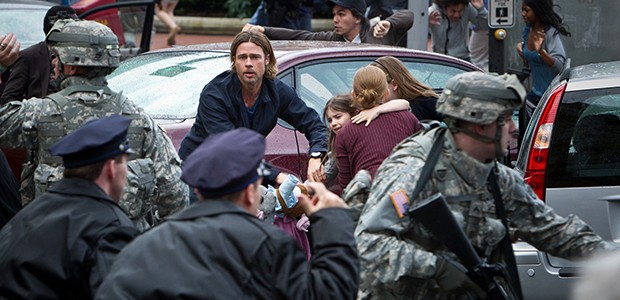Despite all odds and in spite of the much publicized trouble during its production, WORLD WAR Z makes for an exciting, if not entirely fresh, entry into the zombie apocalypse canon, bringing to the fore a different perspective in what has now become an overcrowded and uninspiring genre.
In an age when television has trumped films for some of the most exciting visual experiences, WORLD WAR Z comes at an opportune time. With the growing popularity of Frank Darabont’s WALKING DEAD TV show, simply giving the world another zombie film would never work. Which is why WORLD WAR Z’s superfast, sprinting zombies (think an army of Usain Bolt’s), who attack in waves of hundreds, if not thousands, present an exciting alternative to the usual slow and deformed movements that the world is used to. The story, based on a popular book by author Max Brooks but apparently deviating from this source material considerably, finds Brad Pitt playing Gerry Lane, an ex-UN investigator who is called out of retirement from his idyllic family life when the pandemic hits global scale and entire cities start toppling to crazed, frenzied attacks of the infected.
The film’s opening moments, set in Philadelphia, are its finest – featuring a horde of attackers who strike without warning, the confusion and chaos that results feels real, almost palpable. Caught in this are Gerry’s wife and two daughters and this family presence helps enhance the stakes considerably. It’s a shame that the film drops them from the storyline almost entirely when Gerry is sent to examine the origins of the virus from the earliest known occurrence (referred to as Patient zero) in South Korea. The narrative takes on a globetrotting approach, moving the setting to Jerusalem and then finally Cardiff, all unglamorous locations, but this never really detracts from the original purpose – to investigate and find a cure. In that respect, Z is nothing more than a proficient fear based thriller (think CONTAGION with zombies) because the scares are scarce and action largely subdued, favouring tense setups (such as the exciting, if somewhat clichéd finale in an isolated lab) and conversations between people caught in this situation.
Strictly speaking, what makes WORLD WAR Z believable (not that any zombies exist in reality) is that the affected are less undead, more infected ala the groundbreaking 28 DAYS LATER and therefore their actions aren’t orthodox. This would explain how in their frenzied moments of attack, they are able to climb over one another and form a pillar of bodies that allows them to reach over walls, climb onto buildings and even, rather incredulously, bring down moving helicopters. Pitt’s believable fear for his family, stationed on a large aircraft carrier at sea and Marc Forster’s effective work behind the camera (finally returning to form) complete the package. Though not quite the mother of all zombie movies, WORLD WAR Z does attempt reinvention and as a result, ends up at least feeling like a competent greatest hits collection of zombie thrills.
Rating: 




